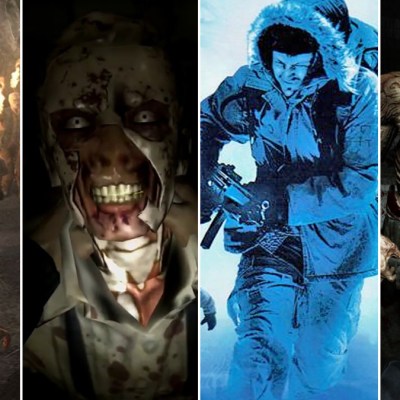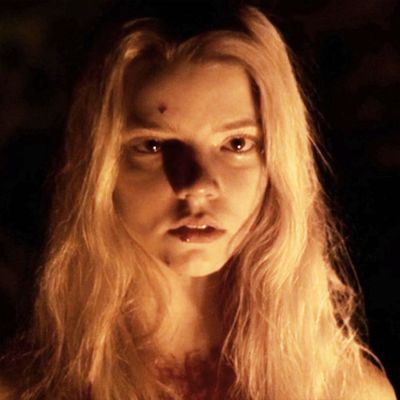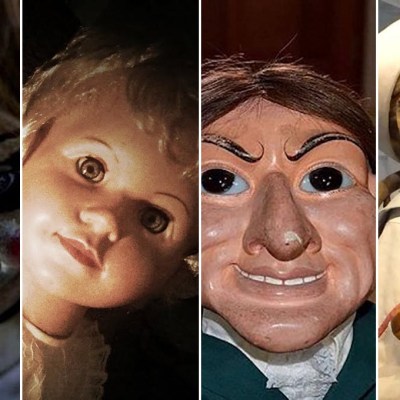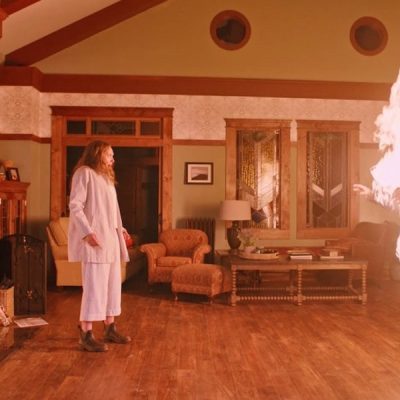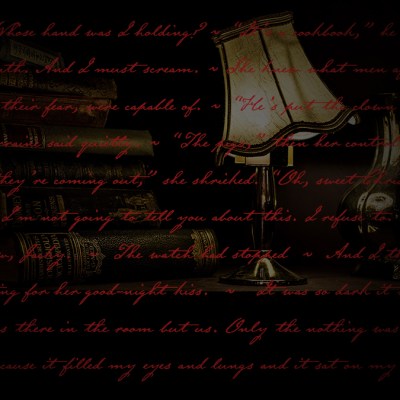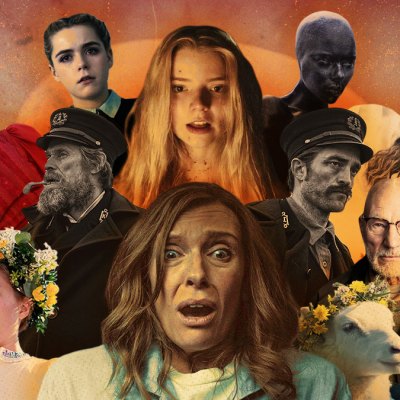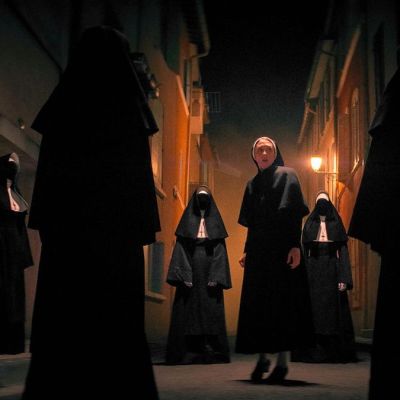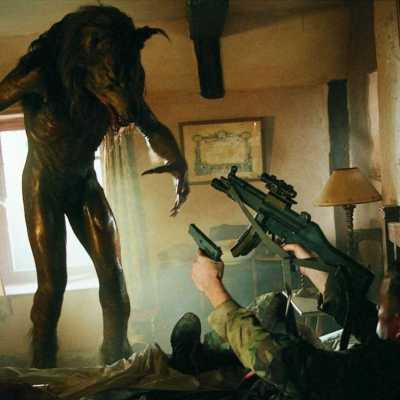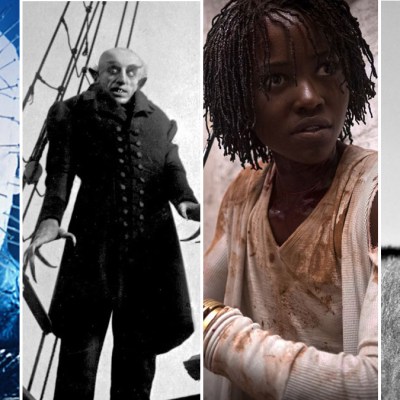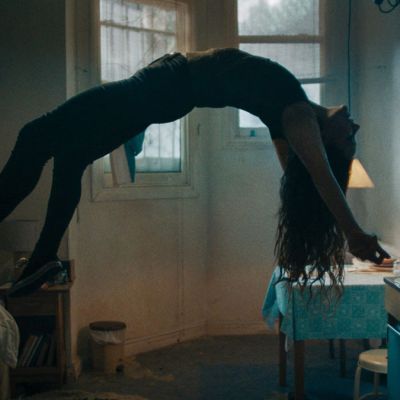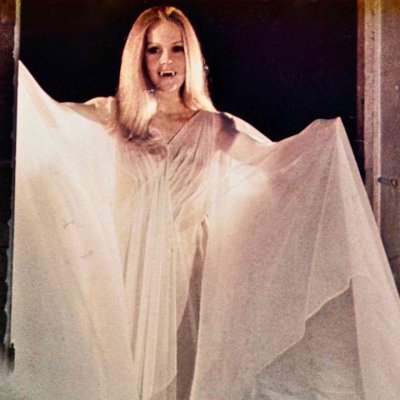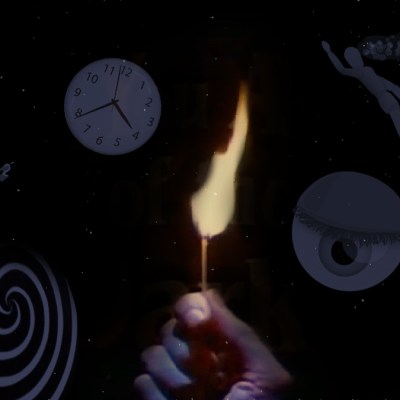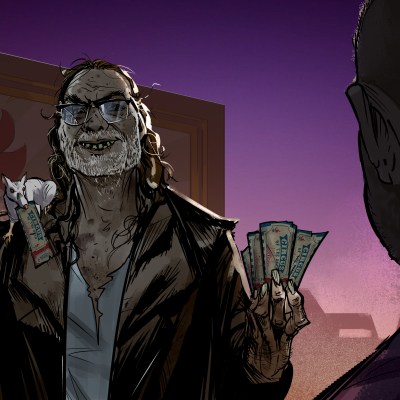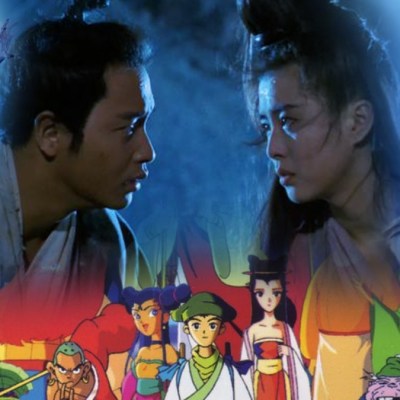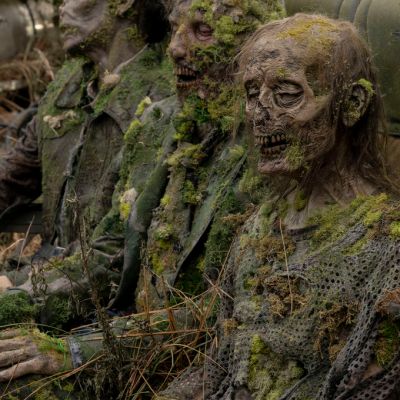The Best Creepy Horror Movies
These horror movies don't use cheap thrills to get scares. They rely on atmosphere and suspense rather than gore and jump-scares.
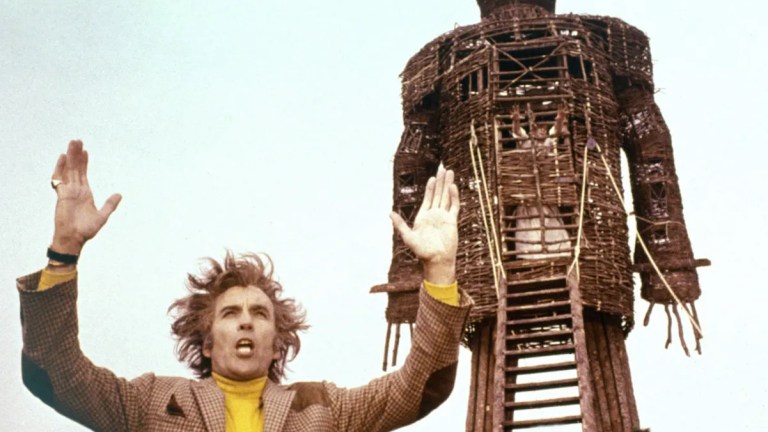
Creepy isn’t the same as scary.
Of course horror movies can be scary simply by using loud noises and sudden movements to make their audiences jump, but creepy is harder to pull off. To be effectively creepy, a film needs to establish a certain atmosphere; it needs to draw you in and make you care. It needs to give you something to think about when you’re trying to drop off to sleep at night; to make you wonder whether that creaking noise down the hallway was just the house settling or something lurking in the shadows. Creepy stays with you. It gives you goosebumps.
Here are 85 of the best horror movies (in no particular order) to chill your bones. Enjoy the nightmares.

Us (2019)
Jordan Peele’s follow up to his award winner Get Out is another social horror. While it might not be quite as accomplished or coherent as Get Out (the end is a bit of a mess) Us is arguably scarier than Get Out as a family staying in a holiday home find themselves tormented by evil replicas of themselves. It’s a film that keeps you constantly on edge with the performances of the main cast – Lupita Nyong’o, Winston Duke, Shahadi Wright Joseph and Evan Alex – absolutely pitch perfect and never less than convincing as good and evil versions of themselves.
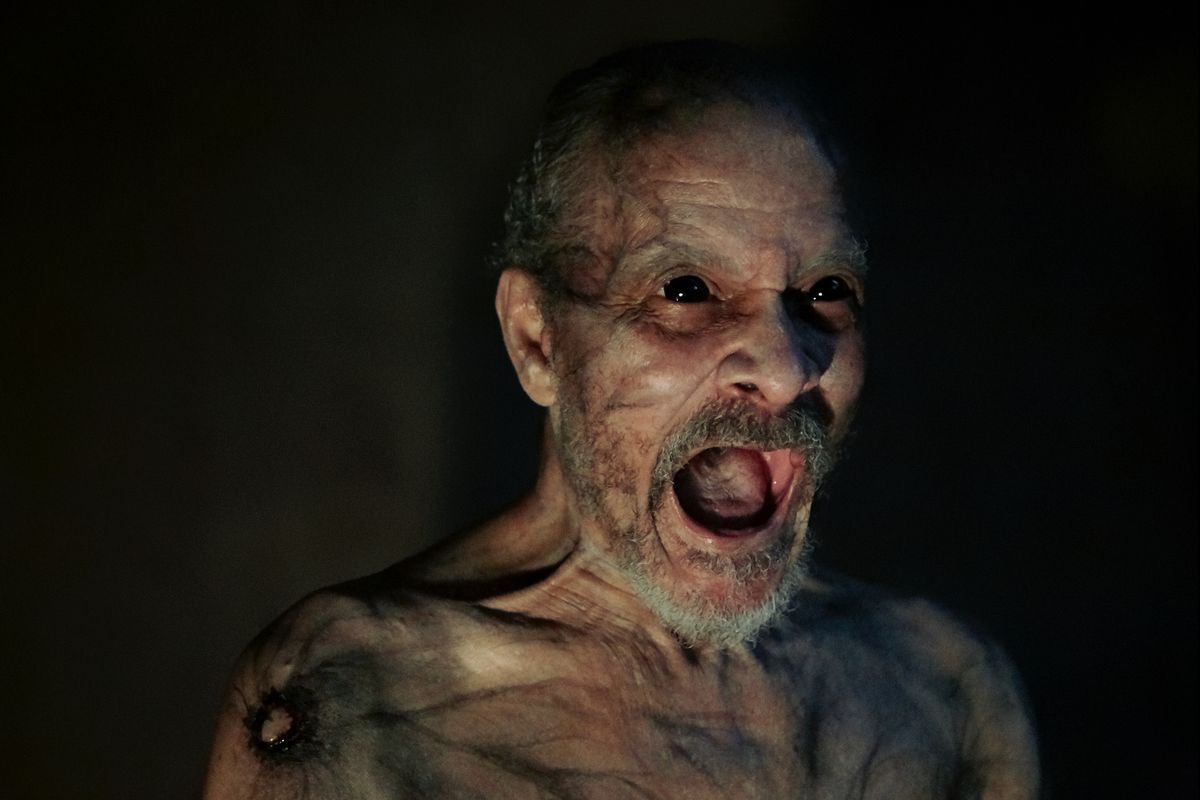
It Comes At Night (2017)
Though the marketing material was somewhat misleading, featuring the above scary-looking dude (who really isn’t a big part of the film at all), It Comes at Night, from director Trey Edward Shults is a claustrophobic slow-burner that insidiously ramps up the creep factor. Joel Edgerton plays the patriarch of a family holed up in a cabin in the woods to escape an unnamed wide spread virus. But when a man, his wife and their young child arrive seeking shelter his family life is disrupted. A coming-of-age horror with one of the bleakest endings around.
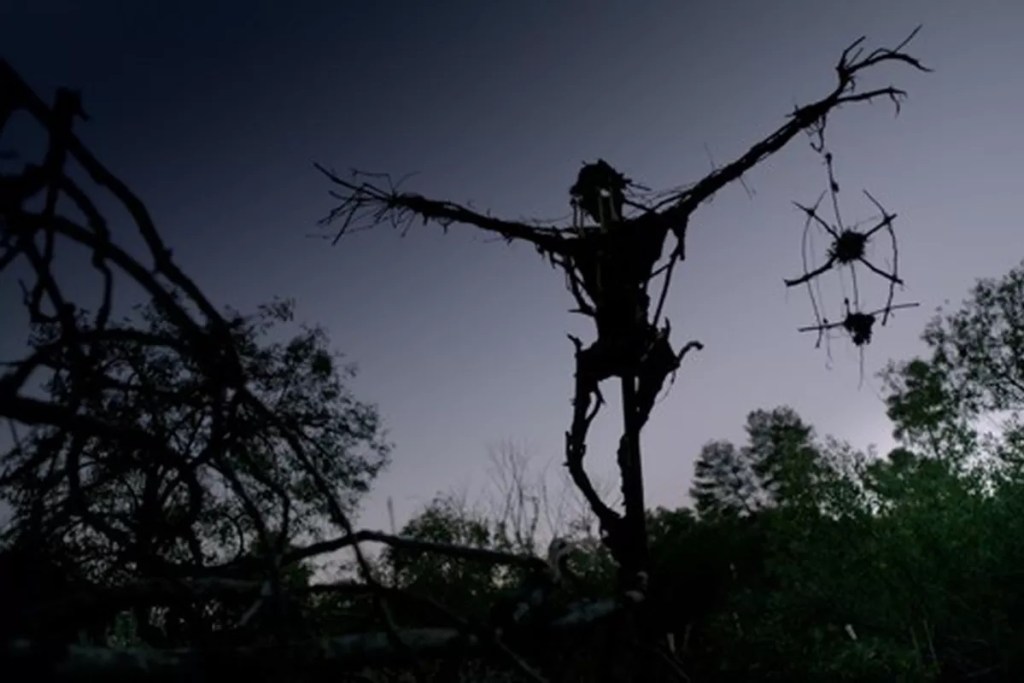
Mr. Jones (2013)
Nobody knows who Mr. Jones is. The artist is a recluse, but his bizarre sculptures have made him world famous. When a documentary maker and his girlfriend stumble across what looks like his workshop, they become obsessed with finding out the truth about Mr. Jones, but the truth isn’t particularly easy to stomach.
One of the most stylishly shot found footage movies you’ll ever see, the makers know the rules of the genre well enough that when they break them, it adds to the story rather than detracting from it. Also, those scarecrows are petrifying.
Under the Shadow (2016)
Set in war-torn Tehran in the late 1980s, Under the Shadow sees a would-be doctor battling the forces of evil for her daughter (and her sanity) even as everyone around her flees to safer ground. The juxtaposition of earthly and unearthly threats makes this a uniquely terrifying film, and Shideh (Narges Rashidi) is a wonderfully complex and sympathetic heroine. Not many films could make a sheet of printed fabric terrifying, but Under the Shadow manages it.
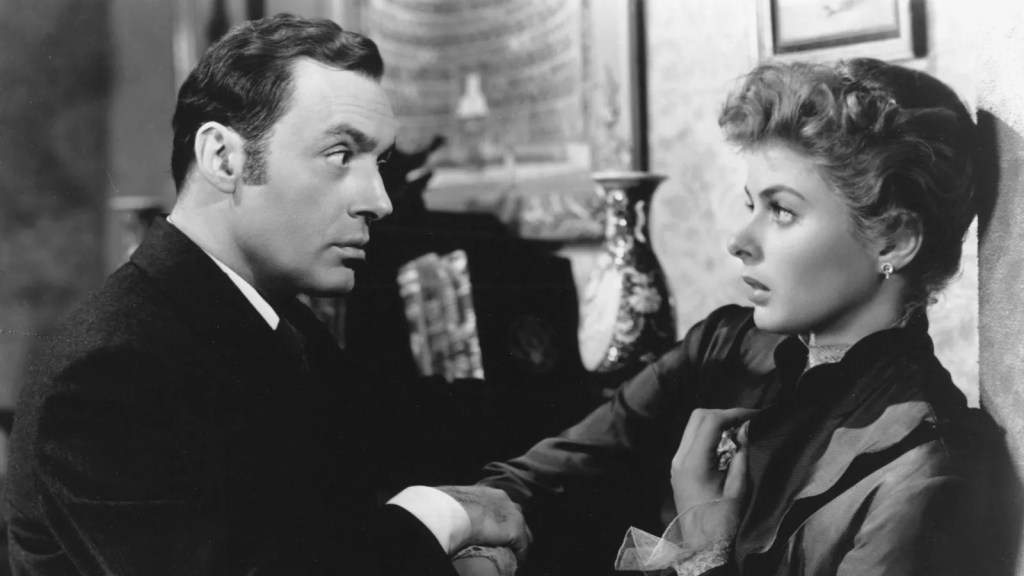
Gaslight (1940)
Bella (Diana Wynyard) thinks she’s losing her mind. She keeps losing things, and the lights in her house seem to flicker, even though her husband Paul (Anton Walbrook) tells her he can’t see anything wrong. Plus there are those footsteps upstairs… Just from that description, you might think that Gaslight will turn out to be a haunted house story, but the real explanation for all the weirdness is far more sinister than that. Walbrook does sinister like no-one else.
The Babadook (2014)
A character from a terrifying kids book comes to life to haunt a single mother (Essie Davis) grieving for the loss of her husband in this beautiful, sorrowful meditation on depression and despair. Top-hatted Mr. Babadook with his horrible, terrible grin is of course creepy as all, but Noah Wiseman as her needy and uncontrollable child gives him a run for his money in creepiness.
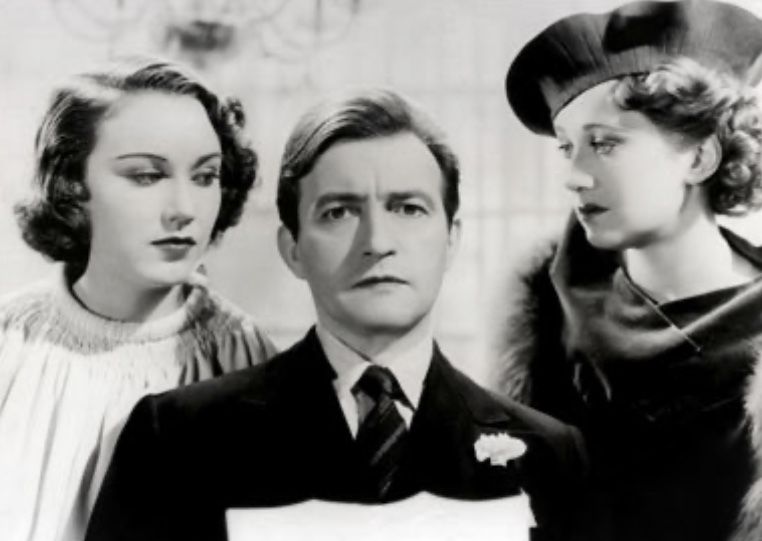
The Clairvoyant (1934)
Maximus, King Of The Mind Readers (Claude Rains) performs amazing feats of clairvoyance on stage every night in front of adoring audiences. The problem is, it’s fake – the mind-reading is all done through a secret code Maximus has invented to communicate with his assistant wife, Rene (Fay Wray). But one night, he meets Christine (Jane Baxter), and his abilities become real. He really can predict the future. If you’ve already guessed that’ll turn out to be more of a burden than a gift, you’re right. Gorgeously shot, wonderfully acted, this is a creepy delight.
Sleep Tight (2011)
The second Jaume Balaguero film on this list is just as bleak and horrifying as the first: Sleep Tight sees a concierge secretly breaking into the homes of the people he’s supposed to serve to try to make them as miserable as he is. When Cesar (Luis Tosar) finds one tenant is harder to upset than the others, his behaviour escalates until he’s committing unimaginably grotesque crimes against the poor girl. The ending will have you shuddering in your seat.
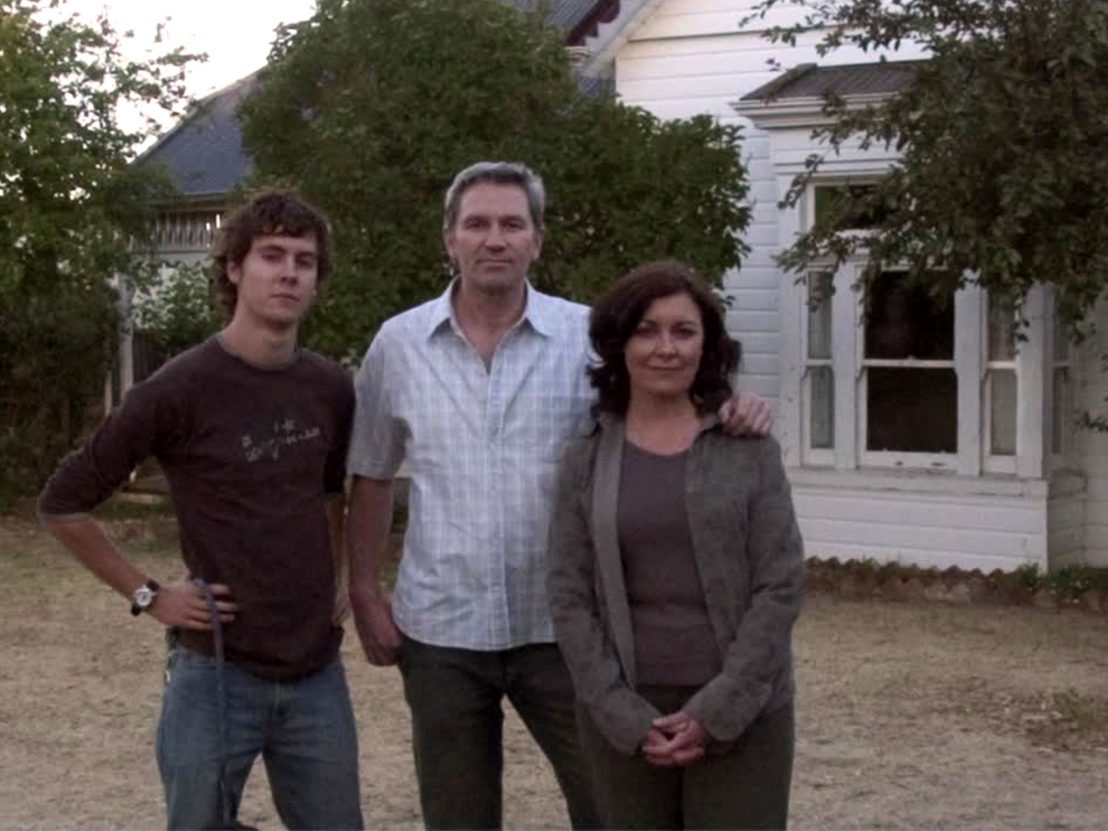
Lake Mungo (2008)
This strange found footage film from Australia takes the format of a mockumentary focusing on the family of a dead girl who think there are supernatural goings on surround their house. It owes a debt to Twin Peaks in its odd neighborhood vibe, and the twisty plot holds many surprises, as the movie wrong foots the audience time and again. It’s creepy throughout but by the time you finally discover what’s really going on it’s not only terrifying but emotionally devastating too.
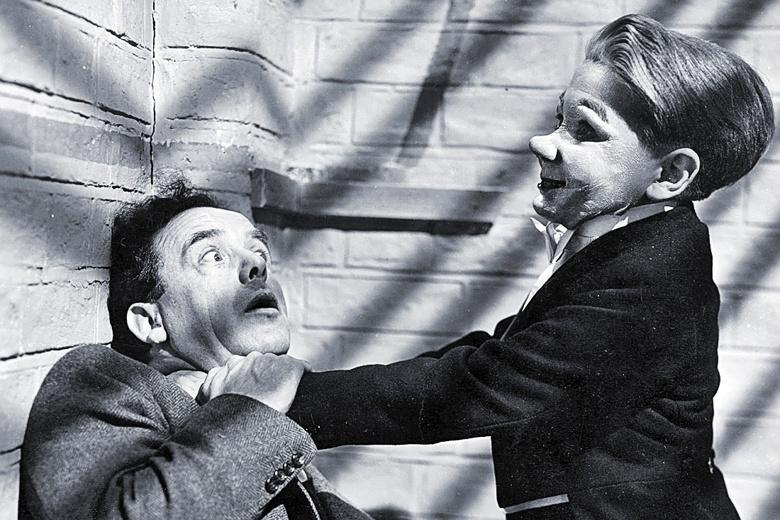
Dead of Night (1945)
Probably the best horror anthology ever made, this Ealing Studios production includes five individual stories and one wrap-around narrative. The wrap-around sees a consultant arrive at a country home only to find that he recognizes all of the guests at the house – he’s seen them all in a dream.
Spooked, the guests start recounting their own stories of the uncanny, each more unnerving than the last. Well, except for the one about the golfers, but that one’s just there for light relief before the film hits you with the scariest ventriloquist’s dummy ever committed to film. Just excellent, all round.
Hereditary (2018)
One of the most truly harrowing movies of recent years is Hereditary, the feature debut from Ari Aster. Toni Collette stars as a mother trying to hold together her family in the aftermath of a tragedy while around her supernatural goings on begin to escalate.
Hereditary has been called The Exorcist for a new generation, though it’s so much more than that. In fact at times, Hereditary is almost too scary, so oppressive is it’s escalating anguish and dread. This one is pure nightmare fodder.
Nina Forever (2015)
Rob (Cian Barry) can’t get over his ex-girlfriend. Nina (Fiona O’Shaughnessy) died in a car crash, which is bad enough, but when he tentatively begins a relationship with his co-worker, Holly (Abigail Hardingham), he finds himself haunted by Nina. Literally. She materializes in his bed every time he and Holly have sex – she might be dead, but she’s not letting go.
“Creepy” doesn’t feel like a strong enough word to describe this film – “devastating” might do it. It’s a sensitive and horrifying portrayal of grief, with a sense of humour as dark as the inside of your eyelids, and some extremely upsetting gore. Brilliant, but not one for the faint-hearted.
Robin Redbreast (1970)
When she moves away from London to a tiny country cottage, Norah (Anna Cropper) expected the change to be a bit strange, but nowhere near as weird as it ultimately turns out to be. As she gets to know the locals, she finds herself being pushed towards a relationship with karate-loving Rob (Andrew Bradford), and while she’s initially game, she soon discovers that her choices are being made for her. It’s a little bit Wicker Man, a little bit Rosemary’s Baby, and a lot of creepiness.
It Follows (2014)
Inspired by a reccuring nightmare director David Robert Mitchell had in his youth,It Follows is a clever, freaky take on the slasher movie, featuring, well, a sexually transmitted ghost. Maika Monroe plays a young woman haunted by a shape shifting spectre after a sexual encounter who slowly but relentless trails her everywhere – the film plays with the audience expertly, making us guess whether background characters could really be the monster. Ultra modern and highly effective, this one will leave you jumping at shadows long after the credits roll.
The Masque of the Red Death (1964)
A tyrannical landowner is plagued by, well, a literal plague in Roger Corman’s adaptation of an Edgar Allan Poe story. Vincent Price plays the Satanic Prince Prospero, who rules over his village with an iron fist, condemning people to death for the mildest offence and abducting any woman who takes his fancy, but all of his evils come back to haunt him when he throws a masked ball and Death shows up. Fittingly, it’s got the hallucinogenic quality of a fever dream, and the various incarnations of Death are wonderfully creepy.
As Above, So Below (2014)
A group of explorers heads deep into the Paris catacombs, only to find they’ve gone a little too deep and stumbled into an alternate dimension that might actually be Hell. It’s a brilliantly over the top concept, and the way it plays out is incredibly eerie. Yes, it’s found footage, and yes, it’s a little bit on the silly side – it chucks in quotes from Dante and a few too many sad-faced ghosts – but some of the scares along the way are properly frightening. Suspend your disbelief and let it freak you out.
Oculus (2013)
Eleven years ago, Alan (Rory Cochrane) bought an antique mirror… and then died, along with his wife. According to the police, they were murdered by their 10-year-old son. According to their daughter, the mirror is haunted, and something supernatural caused their deaths. Now Tim (Brenton Thwaites) is out of prison, Kaylie (Karen Gillan) wants to prove he was innocent by conducting an experiment on the mirror… But inadvertently puts both of them in danger all over again.
It’s chilling. The way director Mike Flanagan plays with reality, building unbearable uncertainty through camera angles and false memories, makes this film both incredibly scary and impossibly sad.
The Witch (2015)
After being cast out of a New England plantation for not interpreting scripture in the same way as the colony’s elders, a family strikes out alone, and soon discovers how inhospitable their unfamiliar new home country can really be. The Witch is a period piece, and the language is suitably archaic, but don’t let that put you off: it’s a brilliantly chilling portrayal of Puritan life, where belief can mean the difference between life and death, and horror is only ever one failed crop away.
The Amityville Horror (1979)
The Amityville Horror is the haunted house story. If you were only ever going to watch one haunted house movie, it should be this one, because this is the archetypal story: a family moves into a house where horrible murders happened, and then bad things happen to them. It manages a lot of things later imitators didn’t, though, which is that it makes the Lutzes’ decision to buy the house make sense, and also builds the horror slowly, so that they almost don’t notice when the things going wrong in the house switch from annoying issues to outright horror. If you’ve moved house in recent memory, this one’ll hit you where it hurts.
The Conjuring (2013)
If you were only ever going to watch two haunted house movies, the second one should definitely be The Conjuring. James Wan’s ode to ’70s horror has plenty in common with The Amityville Horror, but it also has plenty of ideas of its own – and at least half a dozen moments that’ll make your heart leap into your mouth.
The camerawork, the music, the cute kids stuck in the middle of epic spiritual warfare… it all adds up to a completely terrifying experience. You’ll probably need to sleep with a nightlight for a week afterwards.
The Changeling (1980)
George C. Scott stars as Dr. John Russell in this classic ghost story, which is a favorite of The Others director Alejandro Amenabár. Following the tragic demise of his wife and son, Dr. Russell moves into a rambling Victorian mansion to compose music and pick up the pieces of his life. He’s soon being woken by relentless booming sounds coming from the heating system, precisely at 6am every day… Then there’s the old “apparition in the self-filling bath” trick (actually, this may be the first time this happened onscreen, but it sure won’t be the last).
This is one of those movies which hits up all the clichés: people go into the dark, gloomy attic to search for clues, and to the library to look up old news archives on the microfiche; they visit the graveyard, and finally, hold a séance (which is overwhelmingly creepy). The eerie soundtrack and skilful storytelling result in a film which peels back its mysterious layers slowly for a satisfying finish.
The Hallow (2015)
If you go down to the woods today, make sure you don’t steal anything or break anything, or the Hallow will get you. Tree surgeon Adam and his family move into an ancient farmhouse to start sizing up the land for developers and quickly fall afoul of the supernatural creatures lurking in the trees, which turns out to be a really bad idea. This film’s got it all: foreboding mythology, grotesque body horror, and the most amazing line of foreshadowing dialogue you’ll ever hear.
The Uninvited (1944)
A couple of Londoners holidaying in Cornwall stumble across a gorgeous abandoned house on the seafront and immediately decide they want to buy it. The owner, a grumpy old colonel, is happy to sell it to them on the spot, but his granddaughter is reluctant. Turns out the house has got secrets, and, yeah, a ghost. The dialogue in this film is incredible in a very 1940s kind of way, and the tone can occasionally be accused of jolliness, but it’s also got its moments of proper creepiness. Best enjoyed with a glass of sherry.
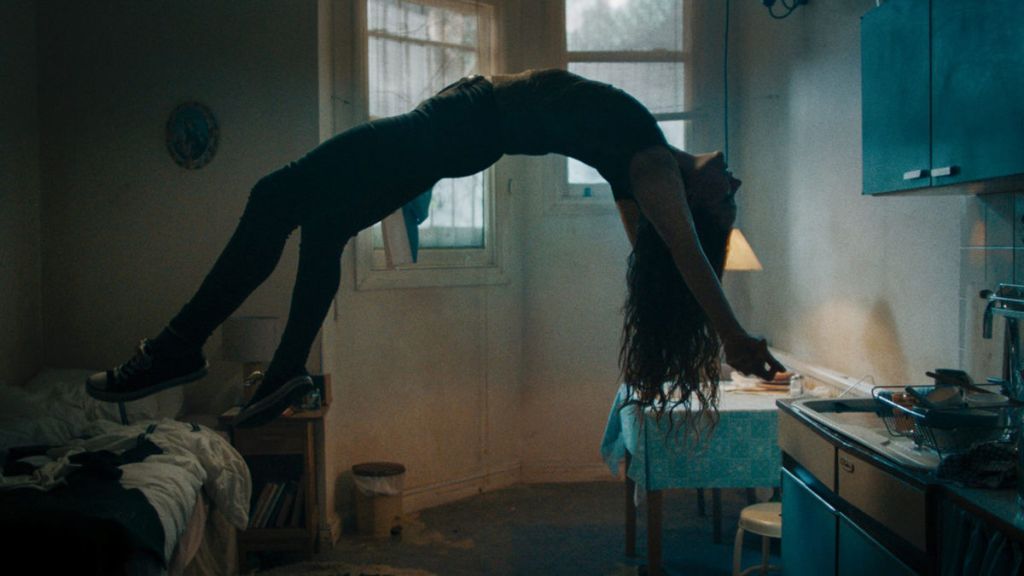
Saint Maud (2019)
One of the best movies of the year, Rose Glass’s feature debut is a study of a young palliative care nurse who starts to believe she’s on a mission from God to save the soul of her dying patient.
It’s a film about conflicts between mind, body and soul, but it leans her into genre territory as Maud (Morfydd Clark) hear God talking to her directly and punishes her own body in an attempt to feel closer to her spiritual side, while the cancer riddled Amanda (Jennifer Elhe) celebrates her body as it lets her down. Shot in Scarborough everything about Saint Maud is unsettling right up to the indelible finale. An absolute must watch.
Crimson Peak (2015)
Director Guillermo del Toro insists that Crimson Peak isn’t a horror film but is, instead, a gothic romance. That doesn’t mean that it isn’t creepy as all get-out, though. When aspiring author Edith Cushing (Mia Wasikowska) meets charming baronet Thomas Sharpe (Tom Hiddleston), she falls madly in love and agrees to move back to his ancestral home, Allerdale Hall – aka Crimson Peak. But the house is crumbling and full of ghosts, and Sir Thomas’s sister doesn’t seem terribly friendly, either…
Del Toro’s visual flair is in full effect here, and every frame of this film (even the scary ones) are stunningly beautiful to look at. It’s a treat.
Baskin (2015)
A group of cops answers a call from the middle of nowhere and unwittingly stumble into something that can only be described as ‘a nightmare’ in this skin-crawlingly nasty Turkish horror. Abrasive, aggressive and deliberately difficult, this is the kind of film that burrows deep into your brain, only to resurface later at the worst possible time. Then again, by the time you’re stranded in the middle of nowhere with only dead colleagues and Silent Hill-style monsters for company, you probably don’t need memories of a horror movie to freak you out.
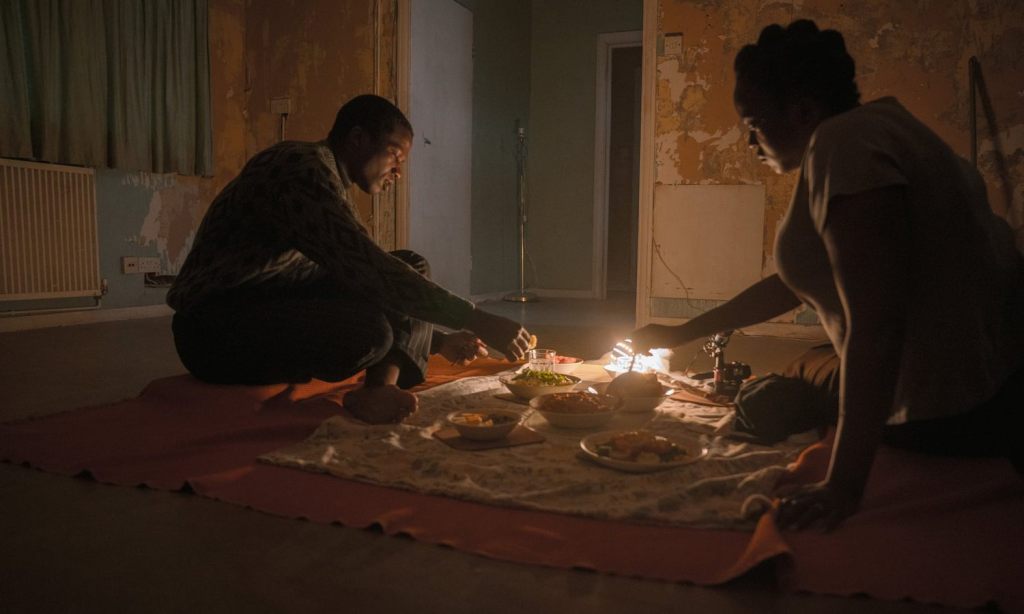
His House (2020)
A Netflix movie which could make a mark come award’s season the directorial debut of Remi Weekes sees a Sudanese refugee couple seek housing in London only to find themselves haunted by ghosts of the past and present. This is proper horror and it’s creepy as hell but it also leans into the horror of the refugee situation with the two marginalized, restricted, and treated as outsiders from the start – it’s a powerful but uncomfortable watch.
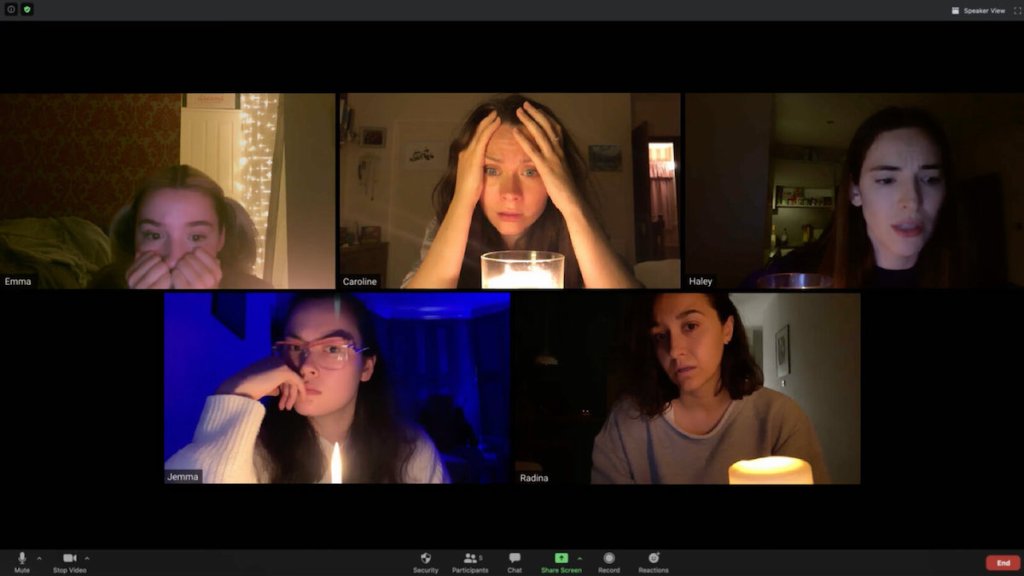
Host (2020)
The defining horror of 2020 – written, shot, edited and released on Shudder in just 12 week – Host is so much more than a lockdown gimmick. Following a group of friends who decide to do a seance via a Zoom chat, this ingenious movie trades on the real life friendships of the cast and crew and the absolute ubiquity of the video software during isolation. It’s seriously creepy too, utilising visions in the shadow but later some seriously impressive stunt work. Director Rob Savage and writer Jed Shepherd have signed up for a three picture deal from Blumhouse on the strength of this movie which absolutely needs to be seen.
The Haunting (1963)
Not to be confused with the remake of 1999, this retro gem not only features some classic sequences of spooky happenings, but a philosophical take on the paranormal. As John Markway says, “The preternatural is something we don’t have any natural explanation for right now but probably will have someday – the preternatural of one generation becomes the natural of the next. Scientists once laughed at the idea of magnetic attraction; they couldn’t explain it, so they refused to admit it exists.
Dr. Markway (Richard Johnson) is investigating the mysterious Hill House, whose inhabitants often die in odd circumstances. With him he has Luke (Russ Tamblyn), the cynical heir to the home, the psychic Theo (Claire Bloom, way too cool for school) and Julie Harris as Eleanor, who has some ghosts of her own but figures a free stay in a mansion is as close to a holiday as she’s going to get. Markway is pleased the ladies haven’t done any research into the bad reputation of the house “So much the better. You should be innocent and receptive.” (The old dog.) This is a great, character-driven story with a dry sense of humor, and a mysterious heroine who feels oddly at home with the supernatural.
Unfriended (2014)
A cautionary tale about the dangers of cyberbullying, Unfriended achieves the seemingly impossible and manages to make the standard sound effects of everyday computer programs terrifying. The whole story is told through one character’s desktop, so you get to watch as she Skypes with her friends, posts to Facebook, or picks something to listen to on Spotify. The details are fascinating, and it’s kind of brilliant how the filmmakers manage to express so much about a character through her browser bookmarks and the messages she types, but doesn’t send. Once the horror kicks in, though, you’ll be too scared to notice much more of the cleverness.
Shutter (2004)
Jane (Natthaweeranuch Thongmee) is driving back from a wedding with her boyfriend Tun (Ananda Everingham) when she hits a girl – in a panic, they leave the body lying in the road and try to get on with their lives. They start feeling rattled when Tun’s photography is blighted by misty shadows and they both suffer from the odd hallucination which seems to show that their hit and run victim (Achita Sikamana) isn’t resting in peace.
Where would horror films be without photographic dark rooms? Even in the digital age, the dim red light and slowly emerging pictures remain classic tools of terror. Not to mention the room with rows of jars containing pickled animals, and the surprise homage to Psycho. This story has it all. There are also touches of dark humor throughout (the praying mantis is a recurring motif) and one of the most bone-chilling scenes has a hilarious payoff.
Directors Banjong Pisanthanakun and Parkpoom Wongpoom skilfully create real characters and have the ability to communicate some of the most powerful and eloquent moments without dialogue. The mystery deepens as more sinister evidence comes to light and the climax is truly chilling. This is one which will stay with you long after Halloween.
Spider Baby (1967)
The Merrye children live out in the middle of nowhere, with only one another and their family chauffeur, Bruno (Lon Chaney Jr) for company. Which is for the best, because they’re all afflicted with the family curse – a bizarre quirk of genetics that causes members of the Merrye family to begin to de-evolve once they reach a certain age. When some distant relatives come to visit, intending to challenge the kids’ right to stay in the house, things go sour fast. It’s a horror comedy, this one, but if you’re not a little bit creeped out by Virginia (Jill Banner), the Spider Baby of the title, and her spider game, well, good luck to you.
What Lies Beneath (2000)
Robert Zemeckis directs Michelle Pfieffer and Harrison Ford in this glossy supernatural thriller, with predictably high quality results. Clare and Norman Spencer live the perfect life – especially now their daughter has left for college and they’re enjoying empty nest syndrome. But the neighbors are causing some concern – especially when the wife disappears and Claire believes she is trying to communicate with her from “the other side.”
Zemeckis has admitted that this is his homage to Hitchcock, and true to form, the suspense builds deliciously slowly. When Claire starts seeing faces in the bathtub (where else?) she goes to talk it over with a psychiatrist. A session with a Ouija board proves that somebody is trying to contact Claire, and it’s not long before she’s stealing keepsakes from grieving parents and reading books with chapters helpfully entitled “Conjuring the Dead.”
The result is a strong movie whether you’re enjoying the ghost story or the “Yuppies in peril in a beautiful house” aspect of it (and it doesn’t hurt that Michelle looks luminously beautiful).
Cat People (1942)
Serbian immigrant Irena doesn’t have a friend in the world when she meets Oliver. He’s kind and attentive and they soon fall in love, despite Irena’s lack of physical affection. She’s convinced she’s living under a curse that will mean she’ll transform into a panther and kill any man she kisses, and despite seeing a (deeply inappropriate) psychiatrist, she can’t shake her beliefs. Oliver is initially patient but eventually finds himself falling for his much more reasonable colleague, Alice. There’s no way this love triangle can end happily and, well, it doesn’t. Cat People is sad as well as eerie, with an increasingly paranoid atmosphere enhanced by skillful shadow play.
The Nameless (1999)
Five years after her daughter Angela went missing, presumed dead, Claudia starts getting weird phone calls. A female voice claims to be Angela, and begs her mother to save her. A series of weird clues leads Claudia to investigate a weird cult… but when things slot into place too easily, it seems like someone might be luring her into a trap. Thematically, The Nameless is similar to Jaume Balaguero’s later film Darkness; there’s a similar feeling of hopelessness and despair, a creeping horror that doesn’t let up, topped off with a horribly downbeat ending. Brrrr.
Dead End (2003)
The Harrington family are driving home for Christmas when they decide to take a shortcut. Obviously, that turns out to be a bad idea. Picking up a mysterious hitchhiker is an even worse idea. Dead End isn’t a particularly original movie, and it does have a truly awful ending, but there’s something about its characters, its atmosphere, and the way it tells the well-worn story that’s really effective. And creepy, of course.
The Others (2001)
Every ghost story introduces an element of uncertainty: are these things really happening, or are they in your head? Like The Innocents, The Others is partly inspired by Henry James’ novella The Turn Of The Screw. Grace (Nicole Kidman) has turned being neurotic into a fulltime job; her children apparently suffer from a sensitivity to light, which means the gothic mansion they inhabit must be swathed in thick curtains at all times. This makes things difficult for the new servants, who have turned up in a most mysterious manner…
Grace’s daughter has an imaginary playmate called Victor; her insistence that there are “other people” in the house vexes Grace until she begins to hear them, too. A piano playing by itself, shaking chandeliers and some truly traumatic hallucinations add to the panic as Grace questions exactly who she is sharing her home with. The tension builds to almost unbearable heights before a truly haunting ending. An intelligent script with a superb twist, quality acting and an atmospheric set (complete with graveyards, mist and autumn leaves) – what more could you want in a creepy movie?
Night of the Living Dead (1968)
“It is happening, and no one is safe.” Night of the Living Dead features some of the most brilliantly ominous radio broadcasts in all horror. When a group of strangers end up trapped in an isolated farmhouse together after the dead begin to rise, no one is in the mood for making friends, and it’s their own prejudices and stubbornness that leads to their downfall. (Well, that, and the fact that no one realized getting bitten by a ghoul would lead to death and reincarnation. Oops.)
The zombie imagery is some of the most haunting ever committed to film, as vacant-eyed ghouls wander in and out of the shadows, chewing on dismembered body parts as they lurch around, constantly in search of fresh meat…
Candyman (1992)
Say his name five times into a mirror and the Candyman appears. Despite his sweet-sounding name, that’s not something you really want to do: Daniel Robitaille was a murdered artist, stung to death by bees in a racist attack, and so he tends not to be in a good mood when he shows up. Set in an urban tower block, this film demonstrates that horror can strike anywhere, not just in spooky old mansions in the middle of the countryside. It’s gory, grimy, and really quite disturbing.
M (1931)
A child murderer is stalking the streets of Berlin and, as the police seem unable to catch him, tensions run high. In an attempt to stop the nightly police raids, the town’s criminals decide to catch the killer themselves, and a frantic chase begins. Though there’s no actual onscreen violence, Peter Lorre is amazingly creepy as the whistling killer, and there’s a sense of corruption pervading the whole film. (Since both Lorre and Fritz Lang, the director, fled the country in fear of the Nazis soon after the film was made, it’s tempting to speculate on what M might be saying about Germany at the time, which only makes it all the creepier.)
The Blair Witch Project (1999)
An early example of the found footage genre, The Blair Witch Project has been aped and parodied by everyone and their grandma, but there’s something unsettling about it that hasn’t quite gone away. Most of the film is improvised; the actors are really filming the scenes themselves, working from a loose outline of the plot, but without prior knowledge of what half the scares were going to be. That ambiguous ending lets you make up whatever explanation you like for the events of the film, which means whatever the scariest thing you can think of is, that’s what the film is about.
The Orphanage (2007)
Laura (Belén Rueda) is returning to her childhood orphanage with her husband and son in order to open it as a care home for children with disabilities. She’s busy, but still has time to notice that seven year old Simón (Roger Príncep) has found an imaginary friend, Tomas. He might have a sack over his head, but what’s a little creepy mask between pals?
Simón is adopted, so it’s only a little odd when a social worker shows up without an appointment. It’s slightly more odd that she’s snooping around in the shed at night. During a daytime party, Laura has an encounter of her own with a masked child, and then experiences every parent’s nightmare: Simón is missing. What follows is the story of a mother who takes the search for her son to the limits of her sanity. Geraldine Chaplin makes an appearance as the medium who conducts possibly the most spine-tingling of all onscreen séances, and there are some truly terrifying shocks during Laura’s search for the truth.
Director JA Bayona makes every shot count; the movie is visually beautiful as well as fantastically sinister. It’s a bona fide horror film but the ending might make you cry.
Ring (1998)
Ring isn’t a perfect film. It’s a bit too long and ponderous and there’s a bit too much irrelevant mysticism in there. But in terms of pure creepiness, it’s pretty damned effective. The idea of a cursed videotape was brilliant – who didn’t have zillions of unmarked VHS tapes lying around the house at the time? – and that climactic scene where the image on the screen crossed over into reality is bloodcurdling. Sneaky, too, since it managed to suggest that no one was safe. Especially not you, gentle viewer, because didn’t you just watch that cursed tape, too? An awful lot of people must have breathed a sigh of relief once their own personal seven-day window was over.
The Innocents (1961)
Based on Henry James’ The Turn of the Screw, this film sees a young governess heading out to an isolated old house to take care of two young children who appear to be keeping secrets from her. Their previous governess died, along with another of the house’s servants, but their influence still seems to be lingering about. Or is it? Just like in the original story, it’s possible to read the ghosts either as genuine spectres or as the fevered imaginings of an over-stressed and under-sexed young woman. Either way, though, the film is terrifying.
The Skeleton Key (2005)
In a decaying house on an old plantation, an old man is dying. Caroline is hired as his carer, but although her job should be simple enough, she begins to suspect that something weird is going on – especially when she finds a secret room in the house’s attic filled with spell books and other arcane bits and bobs.
Is the old man actually under a spell? Why does he seem so terrified of his wife? And might Caroline herself be in danger? The Skeleton Key is one of those films that’s far better than it has any right to be; it slowly ratchets up the tension to a crazy finale and ends on an incredibly creepy note.
Insidious (2010)
Insidious uses just about every trick in the book to creep out its audience, and for some people, that might seem like overkill. There are lurking monsters around every corner; there’s a child in peril; there are wrong-faced nasties; and there are screeching violins every five minutes. On repeat viewings, the plot doesn’t quite hold up (halfway through, the film switches protagonists, which is baffling) and the comedy relief seems grating rather than funny. But the carnival atmosphere, the nods to silent German Expressionist films, the demon’s bizarre appearance, that dancing ghost… there’s something brilliant about it, nonetheless.
Dark Water (2002)
Part of the initial wave of soggy dead girl movies, Dark Water is occasionally very daft, but still effectively creepy. Yoshimi Matsubara is a divorcee, forced by circumstances to move into a crumbling apartment block with her young daughter, Ikuko. Their new home isn’t in the nicest of areas, but it might be alright if it weren’t for the leaky ceiling – and, um, that creepy little girl lurking in the shadows, the one who’s never there when you take a second look. Directed by Hideo Nakata and based on a book by Koji Suzuki, Dark Water might not be as terrifying as Ring, but it’s still pretty eerie.
A Nightmare On Elm Street (1984)
The effects are dated, and the sequels utterly killed Freddy Krueger’s menace, but the first A Nightmare on Elm Street film is still creepy, in its way. The premise is amazingly disturbing – a dead child molester is attacking children in their dreams – and, combined with some of the deeply weird nightmare imagery in this film, it’s more than enough to give anyone a few sleepless nights. All together now: one, two, Freddy’s coming for you…
Uzumaki (2000)
Slowly, inexplicably, a small town is taken over by spirals. Some people become obsessed; others are killed, their bodies twisted into impossible positions. Uzumaki is a live action adaptation of the manga of the same name, and it’s incredibly weird. Unspeakably weird. Visually, it’s incredible, although the green filters look less interesting than they used to due to overuse by every horror and sci-fi movie since. Still, most films don’t go to the extremes that Uzumaki does.
The Devil’s Backbone (2001)
Yup, it’s another soggy dead kid movie, but this time the kid is a boy and the action is set in civil war-era Spain. A young boy is sent to a creepy orphanage, where the other boys scare one another by telling stories about the resident ghost, Santi, who was killed when the orphanage was bombed. Written and directed by Guillermo del Toro, this isn’t your average ghost story – it’s a companion piece to Pan’s Labyrinth, but it’s much more of a horror movie than its better known counterpart.
The Vanishing/Spoorloos (1988)
Saskia and Rex are on holiday when Saskia suddenly, inexplicably, disappears. Rex dedicates his time to trying to find her, but to no avail. He can’t move on, can’t live with the uncertainty, so when Saskia’s kidnapper reveals himself and offers to show Rex what happened to her, his curiosity wins out. It’s a simple yet eerie story with an utterly devastating ending.
Audition (1999)
Takashi Miike’s Audition is more often described as extremely disturbing rather than creepy, but if you can get over that ending (which, let’s be honest, most of us watched through our fingers or from behind a cushion while shouting “NO NO NO NO NO” at the screen), the rest of the film may well creep you out. It starts off slow: a middle-aged man is thinking about dating again, but rather than trying to meet women via traditional methods, he holds a series of fake auditions for a non-existent movie. He meets Asami, a shy dancer, and starts wooing her – but Asami isn’t as sweet and innocent as she seems. Pretty much every character in this movie is an awful person, and the way they treat one another is disturbing on many, many levels.
One Missed Call (2004)
Also directed by Takashi Miike, One Missed Call is a parody of the endless string of soggy dead girl movies made in Japan at the time. But somehow it’s still really creepy. The premise is that, as the title suggests, teenagers are receiving missed calls on their mobile phones. The mystery caller leaves a horrifying voicemail: the sound of the phone’s owner screaming in agony. And since the call came from the person’s own phone, and appears to come from a few days in the future, it’s clearly a sign of impending doom. Sure enough, the kids all die just as the missed call predicted. There’s a nasty little backstory about evil little girls, and a bonkers televised exorcism, and generally, it’s a great film whether you love or loathe stories about scary dead kids.
The Last Man on Earth (1964)
You might’ve thought about how you’d survive the apocalypse, but have you ever stopped to consider whether it’s actually worth doing? In The Last Man On Earth, Vincent Price is the only survivor of a mysterious plague that’s turned the rest of humanity into walking corpses, hungry for his blood. Every day, he tools up and goes out to kill the bloodsuckers; every night, they surround his house and try to kill him. It’s a dismal way to live, and a depressingly eerie film. It’s based on Richard Matheson’s novel I Am Legend – so skip the Will Smith adaptation and watch this instead.
A Tale Of Two Sisters (2003)
Part melodramatic family drama, part psychological horror, A Tale Of Two Sisters is all scary all the time. When a pair of sisters return from a mental hospital, having been traumatised by their mother’s death, they find their new stepmother difficult to adjust to. The nightly visitations from a blood-dripping ghost don’t help, either. But as always in these kinds of films, nothing is what it seems – you might need a second viewing to get your head round the ending.
Night of the Hunter (1955)
Robert Mitchum might have claimed not to be interested in movies or acting, but he’s great in this. As Harry Powell, a bizarrely religious conman, he’s terrifying, whether he’s preaching about the evils of fornication or chasing the children of his latest victim across the country in an attempt to steal a stash of money he knows they’re hiding. The use of light and shadow in this movie is just stunning; the first time Powell arrives at the Harper house is a particular highlight. Robert Mitchum’s singing voice isn’t half bad, either.
Peeping Tom (1960)
Peeping Tom was so controversial when it was released that it effectively ended director Michael Powell’s career. It’s violent, voyeuristic, and since it tells a story from the villain’s point of view; it’s entirely unsavoury. And it’s wonderful. It looks great, it has an amazingly twisted (and tragic) plot, and Carl Boehm is brilliant as Mark, the awkward, mild-mannered psychopath who feels compelled to murder as a result of his father’s deranged experiments. (That’s not a spoiler, by the way – but if I told you how he killed his victims, that might be.)
Psycho (1960)
Happily, 1960’s other movie about a disturbed serial killer was less of a career-killer. Alfred Hitchcock’s Psycho is wonderful, sodden with guilt and tension right from the opening scene. It’s a shame that so many of its twists are so well-known now, because watching this without knowing what was going to happen must have been brilliant. It’s still great – beautiful to watch, genuinely tense and frequently unnerving – but it has lost some of its shock value over the years. (Also, the bit at the end where the psychiatrist explains everything in great detail is utterly superfluous.) Anthony Perkins’ final twitchy, smirky scene is seriously creepy though.
City Of The Dead / Horror Hotel (1960)
Getting the timing of a holiday wrong can have disastrous consequences, as City Of The Dead illustrates. Nan Barlow is a history student who, under the tutelage of Christopher Lee’s Professor Driscoll, becomes fascinated with the history of witchcraft, and decides to visit the site of a famous witch trial… but she arrives in town on Candlemas Eve, probably the most important date in the witches’ calendar. Um, oops.
City Of The Dead is often compared to Psycho, and there are enough similarities between the films that you could assume it was a cheap rip-off – but though the campy US retitling supports that assumption, this was actually made before Hitchcock’s motel-based chiller. It’s definitely creepy enough to be worth watching on its own merits.
Village Of The Damned (1960)
For no apparent reason, one day every living being in the English village of Midwich falls unconscious. For hours, no one can get near Midwich without passing out. When they wake up, every woman in the village finds herself mysteriously pregnant. Obviously, their children aren’t normal, and something has to be done about them… Based on John Wyndham’s novel The Midwich Cuckoos, Village Of The Damned is more of a sci-fi movie than a horror movie – but it’s super creepy nonetheless.
Dolls (1987)
Re-Animator director Stuart Gordon toned things down a bit for this creepy fairy tale, but not much. When a group of awful human beings are forced to spend the night in the home of a couple of ancient toymakers, they soon get their comeuppance at the hands of – well, the title gives that away, doesn’t it? You’ll never look at Toys R Us in the same way again.
The Woman In Black (1989)
When a reclusive old lady dies in an isolated house out in the marshes, a young lawyer is sent to sort out her estate. But there’s something weird about her house, and the townspeople aren’t keen on helping sort things out, either. The TV version of this movie is far, far creepier than the Daniel Radcliffe version; there’s one moment in particular that will etch itself on your brain and continue to creep you out for years after you see it…
The Perfume of the Lady in Black (1974)
Beautifully shot with a great score, The Perfume of the Lady in Black is a dreamy, unsettling film where nothing is ever as it seems. The wonderfully named Mimsy Farmer plays Sylvia, a scientist haunted by melancholy and hallucinations. She’s never quite recovered from her mother’s suicide, and when she goes to a party where talk turns to witchcraft and human sacrifice, her sanity starts to unravel. But are her problems really all in her head, or is there something else going on? The film doesn’t reveal its secrets until the very end, when all that creepiness pays off spectacularly.
May (2002)
May was always a weird child, and unfortunately she’s grown into a weird adult, too. Unable to form any meaningful relationships with the people around her – not even a class of blind children she thinks might be kinder to her than the people who can see how strange and awkward she is – May decides she’ll need to take this “making a friend” business into her own hands. Dark and twisted and incredibly gory, May is as sad and sweet as it is creepy. A lot of that is attributable to Angela Bettis, whose performance is adorably unnerving.
Nosferatu (1922)
In this unauthorised take on Dracula, the evil Count is depicted not as a tragic or romantic anti-hero, but as a horrifying embodiment of the plague – complete with an entourage of rats. Max Schreck makes a brilliantly weird-looking vampire, all teeth, ears and fingernails; his shadow is especially unnerving. Although the ending as presented seems a little abrupt, it’s conceptually horrifying – as is the fact that, due to a copyright claim filed by Bram Stoker’s estate, all but one copy of this movie was destroyed back in the 1920s.
Vampyr (1932)
In a spooky old inn, Allan Grey is visited in the night by an old man who leaves him a gift-wrapped book, with instructions to open it only on the occasion of the man’s death. Which turns out to be soon. The book explains that the town is plagued by vampires – and, helpfully, gives instructions on how to kill them. Vampyr is an early sound film, so while there is some sound and a little dialogue, most of the silent film conventions are still in place. It has a fairly straightforward, Dracula-esque story, but the plot’s not the point. It’s a deliberately strange film, full of disembodied dancing shadows and weird dream sequences; there’s something almost otherworldly about it.
Dracula (1931)
Bela Lugosi is the definitive Dracula. With his eerie eyes and wonderful accent, he’s brilliantly threatening as the charming Count, but despite his iconic performance here, he’s not the creepiest thing about this film. Nope, that honor goes to Dwight Frye’s portrayal of Renfield, the lunatic spider-eater under Dracula’s control. He’s amazing, all awkward body language and hysterical laughter. Lugosi’s oddly cadenced speech has been emulated and parodied a zillion times, which takes away some of its power; Frye’s performance, on the other hand, is just downright disturbing.
White Zombie (1932)
A year after Dracula, Bela Lugosi starred as Murder Legendre, an evil voodoo master, in one of the first ever zombie movies. The zombies here aren’t flesh-eating ghouls but obedient slaves, working tirelessly in Legendre’s mill. Even when one of them tumbles into a grinder, work doesn’t stop. When the plantation owner goes to Legendre for help winning the heart of the girl he loves, he’s handed a dose of the zombie potion – and now the only way to break Legendre’s spell over the innocent girl is to kill him. Lugosi is suitably menacing, and the drone-like zombies are properly eerie.
The Cursed Medallion/The Night Child (1975)
For a few years, in 1970s Italy, Nicoletta Elmi was the go-to creepy kid. She pops up in Mario Bava’s Bay of Blood and Baron Blood, and in Dario Argento’s Deep Red, among others, but she’s never more creepy than she is in The Cursed Medallion. Here, she plays Emily, the daughter of an art historian who’s making a documentary on demons in paintings. She’s given a medallion but, as the title suggests, it’s cursed, and she ends up possessed by the spirit of a murderess. It’s atmospheric, lovingly photographed and, of course, Elmi is awesome in the lead role.
The Descent (2005)
A group of friends go off on a spelunking holiday, but get more than they bargained for when it turns out that the caves they’re exploring are dangerous in more ways than one. There’s enough time spent on character development that you really feel it when the group starts to get thinned out; there’s some incredibly painful-looking gore; and there are some amazingly freaky monsters. Watch it in a darkened room to make the most of its wonderfully claustrophobic atmosphere.
Paranormal Activity (2007)
The shine might’ve come off this movie because the Paranormal Activity franchise has become Lionsgate’s new one-every-Halloween cash cow, but there’s something deliciously creepy about this movie. Rewatching it now, even knowing when all the scares are coming, it’s still chilling. In a neat twist on the traditional haunted house story, Paranormal Activity’s entity haunts a person, not a house – so its victim can’t just pack up and move. The found footage conceit is used to great effect, making you stare intently at grainy nighttime footage of an empty room, straining your ears for distant footsteps, before making you jump out of your skin with a loud bang. (Pro tip: the movie has three different endings, so if you think you’re bored of it, try one of the others.)
Ju-on: The Grudge (2002)
So much of the effectiveness of a horror movie comes down to its sound design. A well-placed creak, groan, echo, or jangle can make the difference between something completely normal and something terrifying. New scary noises don’t come along very often, but Ju-on: The Grudge managed to come up with something unlike any other scary noise you’ve heard before. Its ghost makes a weird rattling, burping groan as she approaches; it’s kind of like a death rattle, kind of like a throttled scream, and it’s creepier than anything you’ve ever heard before. The film is relentless, light on plot and heavy on jump scares, but it’s that noise that’ll stay with you.
Julia’s Eyes (2010)
Julia and her twin sister, Sara, both suffer from the same degenerative disease – one that causes them to go blind. When Sara undergoes experimental surgery and subsequently kills herself, Julia suspects foul play – and, indeed, something weird seems to be going on, with whisperings about an invisible man lurking in the shadows. But as Julia gets closer to the truth, her own eyesight suffers more and more…The film restricts our vision almost as much as Julia’s; it’s almost unbearably claustrophobic, and ultimately heartbreaking.
The Eye (2002)
Another film about eyes and the horrors of going blind, The Eye follows Mun, a classical violinist from Hong Kong, as she undergoes an eye transplant. Although the transplant seems to be successful – Mun can see again – something isn’t right, because now she can see dead people. And most of them are terrifying. The ending is vaguely preposterous, but the rest of the film is creepy enough that it’s forgivable.

Zombie Flesh Eaters (1979)
Lucio Fulci’s unofficial sequel to Dawn Of The Dead features perhaps the creepiest zombies ever committed to film. When a boat turns up in New York harbour with only a zombie on board, investigative reporter Peter West sets out to find out where the boat came from and what’s going on. He ends up on the island of Matool, where the dead are returning to life to eat the flesh of the living… and they’re really, really gross. Zombie Flesh Eaters was initially classified as a video nasty in the UK, and it’s not difficult to see why. Its atmosphere elevates it above your average exploitation movie, though; there’s something really melancholy about it.
[REC] (2007)
When a local news crew decided to tag along with the fire brigade for an evening, they probably didn’t realise they’d end up fighting from their lives in a zombie-infested tower block. Co-written and co-directed by Paco Plaza and Jaume Balaguero (yup, him again), [REC] is a decent enough zombie movie, until the final reel, when it reveals an even more terrifying ace up its sleeve.
Let Me In (2010)
Although remakes are usually terrible, Matt Reeves’ take on this unusual vampire story was both respectful of and different from the original and, for my money, it’s creepier. Lonely tween Owen doesn’t have any friends until the equally strange Abby moves in next door. They embark on an odd friendship/proto-romance, but Abby has a secret: she’s a vampire. The use of a candy jingle is, against all odds, really eerie, and by paring the story down to its most essential elements (and getting rid of that daft cat scene) Let Me In makes for a scarier watch than Let The Right One In.
Carnival Of Souls (1962)
After a traumatic accident, weird things start happening to Mary. A strange man seems to be stalking her, though no one else can see him, and she feels irresistibly drawn to an abandoned pavilion out in the middle of nowhere. Once upon a time, the pavilion housed a carnival, but now it’s just an empty building… or is it? There’s nothing surprising about the plot of this movie to a modern audience – you’ll have the whole film worked out within about five minutes – but it is gloriously creepy. The climactic scenes at the carnival are pure nightmare fuel.
The Shining (1980)
Probably the most effective of all the Stephen King adaptations, The Shining plonks Jack Nicholson down in the middle of a creepy hotel and lets him do his thing. Nicholson plays Jack Torrance, a struggling writer who gets a winter job as caretaker of The Overlook Hotel, where the isolation and/or ghosts send him out of his mind. There are so many creepy images in this film: the twin girls who just want to play, the woman in room 237, the lift full of blood, and, oh, lots more.
The Cabinet Of Doctor Caligari (1920)
Appropriately, watching The Cabinet Of Doctor Caligari feels like slipping into a nightmare. Caligari’s cabinet holds Cesare, the sleepwalker – a catatonic oracle able to answer questions of life and death with eerie accuracy. Is Caligari a hypnotist, a murderer, or both? It’s a strange story, made stranger with a twist ending, and rendered impossibly creepy by the Expressionist production design. The weird, distorted hand-painted sets give the film a crude, unreal beauty and, if anything, the passage of time has increased the film’s creepiness, because it’s so utterly unlike modern films.
The Exorcist (1973)
An obvious choice, but The Exorcist is genuinely scary. It’s deceptively simple: the filming style is realistic, the locations are ordinary-looking and, by comparison to more modern horror movies, there aren’t many elaborate effects or stunts. But the film makes every scary moment count. It’s atmosphere is oppressive, claustrophobic – there’s an ever-present sense of dread throughout. It ought to feel more dated than it does, but even now, the demonic makeup and scratchy voice of the possessed Regan gives me goosebumps.
The Omen (1976)
Damien is probably the ultimate creepy child. Adopted by the Thorns when their own newborn dies, it doesn’t take long for his dark side to emerge: Damien is the Antichrist.
There are so many iconic moments in this film, so many things that have shaped both the horror genre and our culture’s idea of evil; something about this film really struck a chord, and even now it’s pretty effective. Every death scene in this movie is memorable, but the suicide of Damien’s nanny at his birthday party particularly stands out.
Ghostwatch (1992)
Originally shown on UK TV at Halloween, Ghostwatch scared a whole generation shitless. It’s presented as a live broadcast, starring familiar BBC faces: Michael Parkinson plays host, while Sarah Green and Craig Charles report from the scene as a normal family recount their experiences with the terrifying ghost they’ve dubbed “Pipes”. The shadowy figure of a man is glimpsed several times throughout the show, some appearances more obvious than others, and as viewers call in to share their own stories, things get weirder and weirder…Okay, this isn’t technically a film, but it is so amazingly creepy and brilliant that it couldn’t be left off the list.
The Wicker Man (1973)
The Wicker Man is a wonderful mishmash of genres: it’s got humour, horror, singing and sex. It frequently teeters on the edge of absurdity. But at heart, it’s deeply creepy. When devout Christian Sgt Howie visits the isolated community of Summerisle, he thinks he’s investigating the abduction of a little girl – and the villagers certainly do seem to be acting suspiciously. But as his investigation continues, it becomes clear that something entirely different is going on. Howie runs headlong to his doom, and its final scene is downright spine-chilling.
Suspiria (1977)
Suspiria is Dario Argento’s finest hour. It’s eyeball-meltingly beautiful to look at, all unnatural neon lighting and ridiculously lavish set design; the music is cacophonous, a never-ending wall of sound that doesn’t let up; and the plot is, well, it’s functional enough.
Suzy, an American ballet dancer, flies to an exclusive dance school in Germany only to find herself in the midst of a murder investigation – and something weird is definitely going on with the teachers. If you haven’t seen Suspiria in a while, treat yourself to the Blu-ray. There’s nothing restrained about this movie, nothing ordinary; it sneaks up on you and worms its way into your brain. It’s brilliant.
